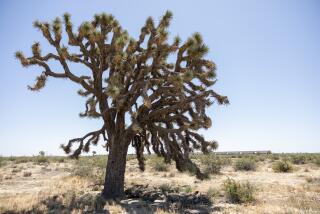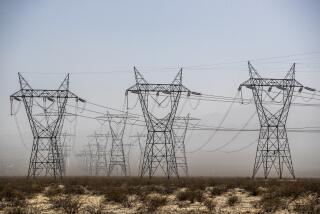All wound up
- Share via
PEOPLE come by the thousands to the hills around Lancaster in spring to gaze at nature with its brights on -- waves of Technicolor poppies stretching to the horizon. But untouched vistas of rolling petals could be history, some flower fans fear, if a proposal to erect about 130 giant wind turbines near the Antelope Valley California Poppy Reserve is approved.
Lancaster resident Michael Powell, a retired engineer, says big wind towers near the poppy preserve would spoil a bucolic scene.
“Views are what people come to the reserve for. It would have a serious impact on the visitor’s experience,” says Powell, a member of Friends of the Poppy Reserve, which is spearheading opposition to the project.
PPM Energy, a Scottish company, wants to build a wind farm on the periphery of the poppy reserve to generate 200 megawatts of electricity, enough juice for about 130,000 houses at peak production.
The turbines would rise about 400 feet, residents say PPM officials told them. The project would link to a transmission line Southern California Edison Co. intends to complete by 2008 that will carry electricity from wind power produced in the Tehachapi Mountains and Antelope Valley to L.A.
A state law requiring that public utilities produce 20% of their energy from renewable sources by 2017 is fueling a boom in wind farms in California’s gusty open spaces. In the Tehachapis, where turbines have spun for 25 years, wind energy production is outstripping transmission capacity, says Edison’s Chuck Adamson, project director of the Antelope Valley Transmission Project. “It’s becoming a very viable technology,” Adamson says.
As gasoline prices skyrocket, wind energy technology improves and the nation looks for cleaner power, more and more utilities are trying to catch the wind. The U.S. Senate approved a bill in July requiring 10% of utilities’ energy sources be renewable by 2020.
PPM is a major player in the field, with wind farms in seven states, including some turbines in the Palm Springs area and a site under development in Solano County in Northern California.
Yet some see wind energy farms as an intrusion into rural space. Some tourists and residents have complained about the huge, swirling fan blades that dot ridges in the Coachella Valley and High Desert. And in the windy Altamont Pass east of San Francisco Bay, giant wind turbines have struck many wild birds, including hawks and eagles.
He says a survey his group took in conjunction with the California Department of Parks and Recreation, which manages the reserve, showed 50% of the visitors to the poppy fields, which has a number of popular hiking trails, would not return if wind towers were erected.
Milt Stark, president of the Poppy Reserve Mojave Desert Interpretive Assn., was part of a group that helped create the reserve in 1976. He says the energy project could block plans to expand the 1,800-acre preserve. Opponents of the project say the wind towers would be built on acreage originally planned for the reserve.
“Our reaction was, ‘Over our dead bodies,’ ” Stark says.
Jan Johnson, spokesperson for PPM, says wind power is a clean fit in rural spaces.
“[It] is compatible with natural uses. I’m standing in a wind field [in Oregon] with wind towers right now, where it’s very compatible and very appropriate with the landscape,” Johnson said.
Johnson says the company tries to earn the trust of local communities. PPM representatives sponsored a booth at the Poppy Festival in Lancaster, met with residents and explained the project to opponents.
The company points to satisfied communities such as rural Sherman City, Ore., where the high school band and cheerleaders inaugurated the second phase of a wind energy project.
“It’s quite an economic boon,” says Sherman County Judge Gary Thompson. “It will generate about $1 million in new ... taxes.”
But in Lancaster, Mayor Frank Roberts is skeptical.
“We have tourism that you wouldn’t believe when the poppies are there,” Roberts says. Some 130,000 oglers jammed the reserve over six weeks during spring’s flower explosion. “I would not like to see that particular area poisoned by these towers,” he says.
Roberts recalls the scene last spring as he flew over the poppy fields in a small plane. “I looked down and saw a sea of gold.”
At least one poppy fan believes the two can coexist.
“Yes, there’ll be white dots on the hills,” says Nancy Ulrich, a Newport Beach real estate agent, whose husband, Bob, has a Web page of poppy photos taken on trips to the reserve. “But suck it up, people. It’s not coal-fired plants spewing junk into the air. I think they [the towers] actually look kind of cool.”
More to Read
Inside the business of entertainment
The Wide Shot brings you news, analysis and insights on everything from streaming wars to production — and what it all means for the future.
You may occasionally receive promotional content from the Los Angeles Times.










